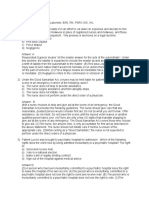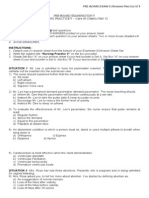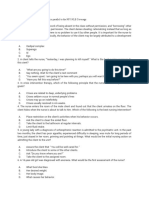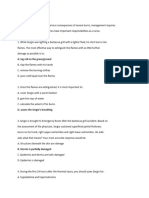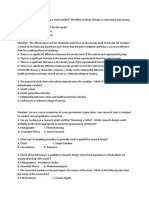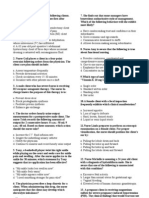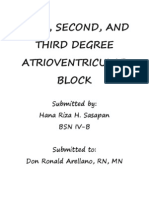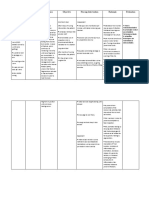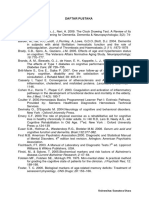NP5
NP5
Uploaded by
Jhouleen Angelika TamCopyright:
Available Formats
NP5
NP5
Uploaded by
Jhouleen Angelika TamCopyright
Available Formats
Share this document
Did you find this document useful?
Is this content inappropriate?
Copyright:
Available Formats
NP5
NP5
Uploaded by
Jhouleen Angelika TamCopyright:
Available Formats
Situation 1: Understanding different models of care is a necessary part of the nurse patient relationship. 1.
The focus of this therapy is to have a positive environmental manipulation, physical and social to effect a positive change. A. Milieu B. Psychotherapy C. Behaviour D. Group 2. The client asks the nurse about the Milieu therapy. The nurse responds knowing that the primary focus of milieu therapy can be best described by which of the following? A. A form of behaviour modification therapy B. A cognitive approach of changing the behaviour C. A living learning or working environment D. A behavioural approach to changing behaviour 3. A nurse is caring to client with phobia who is being treated for the condition. The client is introduced to short periods of exposure to the phobia object while in relaxed state. The nurse understands that this form of behaviour modification can be best described as: A. Systematic desensitization B. Aversion therapy C. Self-control therapy D. Operant conditioning 4. A client with major depression is considering cognitive therapy. The client say to the nurse, how does this treatment works? The nurse responds by telling the client that: A. This type of treatment helps you examine how your thoughts and feelings contribute to your difficulties B. This type of treatment helps you examine how your past life has contributed to your problems. C. This type of treatment helps you confront your fears by exposing you to the feared objects abruptly. D. This type of treatment will help you relax and develop new coping skills. 5. A client state, I get down on myself when I make mistake. Using Cognitive therapy approach, the nurse should: A. Teach the client relaxation exercise to diminish stress B. Provide the client with Mastery experience to boost self esteem C. Explore the clients past experiences that causes the illness D. Help client modify the belief that anything less than perfect is horrible.
6. The most advantageous therapy for a preschool age child with a history of physical and sexual abuse would be: A. Play B. Psychoanalysis C. Group
D. Family 7. An 18 year old client is admitted with the diagnosis of anorexia nervosa. A cognitive behavioural approach is used as part of her treatment plan. The nurse understands that the purpose of this approach is to: A. Help the client identify and examine dysfunctional thoughts and beliefs. B. Emphasize social interaction with clients who withdraw C. Provide a supportive environment and a therapeutic community D. Examine intrapsychic conflicts and past events in life 8. The nurse is preparing to provide reminiscence activity for a group of clients. Which of the following clients will the nurse select for this group? A. A client who experiences profound depression with moderate cognitive impairment B. A catatonic, immobile with moderate cognitive impairment C. An undifferentiated schizophrenic client with moderate cognitive impairment D. A client with mild depression who exhibits who demonstrates normal cognition 9. Which intervention would be typical of a nurse using cognitive-behavioral approach to a client experiencing stress disorders? A. Use of unconditional positive regard B. Classical conditioning C. Analysis of free association D. Examination of negative thought patterns 10. Which of the following therapies has been strongly advocated for the treatment of post traumatic stress disorders? A. ECT B. Group Therapy C. Hypnotherapy D. Psychoanalysis 11. The nurse knows that in group therapy, the maximum number of members to include is: A. 4 B. 8 C. 10 D. 16 12. The nurse is providing information to a client with the use of disulfiram (antabuse) for the treatment of alcohol abuse. The nurse understands that this form of therapy works on what principle? A. Negative Reinforcement B. Aversion Therapy C. Operant Conditioning D. Gestalt therapy 13. A biological or medical approach in treating psychiatric patient is:
A. Million therapy B. Somatic therapy C. Behavioral therapy D. Psychotherapy 14. Which of these nursing actions belong to the secondary level of preventive intervention? A. Providing mental health consultation to health care providers B. Providing emergency psychiatric services C. Being politically active in relation to mental health issues D. Providing mental health education to members of the community 15. When the nurse identifies a client who has attempted to commit suicide the nurse should: A. call a priest B. Counsel the client C. refer the client to psychiatrist D. refer the matter to the police Situation 2: Rose seeks psychiatric consultation because of intense fear of flying in an airplane which has greatly affected her chances of success in her job. 16. The most common defense mechanism used by phobic client is: A. Supression B. Rationalization C. Denial D. Displacement 17. The goal of the therapy in phobia is: A. Change her lifestyle B. Ignore reaction producing situation C. Change her reaction towards anxiety D. Eliminate fear producing situation 18. The therapy most effective for clients with phobia is: A. Hypnotherapy B. Group therapy C. Cognitive therapy D. Behavior therapy 19. The fear and anxiety related to phobia is said to be abruptly decreased when the patient exposed to what is feared through: A. Guided imagery B. Systematic desensitization C. Flooding D. Hypotherapy
20. Based on the presence of symptom. The appropriate nursing diagnosis is: A. Self esteem disturbance B. Activity intolerance C. Impaired adjustment D. Ineffective individual coping Situation 3: Mang Jose, 39 year old farmer, unmarried, had been confined in the National center for mental health for three years with a diagnosis of schizophrenia. 21. The most common defense mechanism used by a paranoid client is: A. Displacement B. Suppression C. Rationalization D. Projection 22. When Mang Jose says to you: The voices are telling me bad things again! The best response is: A. Whose voices are those? B. I doubt what the voices are telling you. C. I do not hear the voice you say you hear. D. Are you sure you hear these voices? 23. A relevant nursing diagnosis for clients with auditory hallucination is: A. Sensory perceptual alteration B. Altered thought process C. Impaired social interaction D. Impaired verbal communications 24. During mealtime, Jose refused to eat telling that the food was poisoned. The nurse considers the following except: A. Ignore his remark B. Offer him food in his own container C. Show him how irrational his thinking is D. Respect his refusal to eat. 25. When communicating with Jose. The nurse considers the following except: A. Be Warm and enthusiastic B. Refrain from touching Jose C. Do not argue regarding his hallucination and delusion D. Use simple, clear language Situation 4: Gringo seeks psychiatric counselling for his ritualistic bahavior of counting his money as many as 10 times before leaving home.
26. An initial appropriate nursing diagnosis is: A. Impaired social interaction B. Ineffective individual coping C. Impaired Adjustment D. Anxiety Moderate 27. Obsessive compulsive disorder is BEST described by: A. Uncontrollable impulse to perform an act or ritual repeatedly: B. Persistent thoughts C. Recurring unwanted and disturbing thoughts alternating with a behaviour. D. Pathological persistence of unwilled thought, feeling or impulse 28. The defense mechanism used by persons with obsessive compulsive disorder is undoing and it is best described in one of the following statements: A. Unacceptable feeling or behaviour are kept out of awareness by developing the opposite behaviour or emotion. B. Consciously unacceptable instinctual drives are diverted into personally and socially acceptable channels C. Something unacceptable already done is symbolically acted in reverse. D. Transfer of emotions associated with a particular person, object or situation to another less threatening person, object or situation. 29. TO be more effective, the nurse who cares for persons with obsessive compulsive disorder must possess one of the following qualities: A. Compassion B. Consistency C. Patience D. Friendliness 30. Person with OCD usually manifest: A. Fear B. Apathy C. Suspiciousness D. Anxiety Situation 3: The patient who is depressed will undergo electroconvulsive therapy. 31. Studies on biological depression support electroconvulsive therapy as a mode of treatment. The rationale is: A. ECT produces massive brain damage which destroys the specific area containing memories related to events surrounding the development of psychotic condition B. The treatment serves as a symbolic punishment for the client who feels guilty and worthless C. ECT relieves depression psychologically by increasing the norepinephrine level D. ECT is seen as a life-threatening experience and depressed patients mobilize all their bodily defenses to deal with this attack. 32. The preparation of a patient for ECT ideally is MOST similar to preparation for a patient for: A. electroencephalogram the
B. X-ray C. general anesthesia D. electrocardiogram 33. Which of the following is a possible side effect which you will discuss with the patient? A. hemorrhage within the brain B. robot-like body stiffness C. encephalitis D. confusion, disorientation and short term memory loss 34. Informed consent is necessary for the treatment for involuntary clients. When this cannot be obtained, permission may be taken from the: A. social worker B. doctor C. next of kin or guardian D. chief nurse 35. After ECT, the nurse should do this action before giving the client fluids, food or medication: A. assess the gag reflex B. assess the sensorium C. next of kin or guardian D. check O2 Sat with a pulse oximeter Situation 6: Mrs. Ethel Agustin 50 y/o, teacher is affected with myasthenia gravis 36. Looking at Mrs. Agustin, your assessment would include the ff except: A. Nystagmus B. Difficulty of hearing C. Weakness of the levator palpebrae D. Weakness of the ocular muscle 37. In an effort to combat complications which might occur relatives should be taught: A. Checking cardiac rate B. Taking blood pressure reading C. Techniques of oxygen inhalation D. Administration of oxygen inhalation 38. The drug of choice for her condition is: A. Prostigmine B. Morphine C. Codeine D. Prednisone
39. As her nurse, you have be cautious about administration of medication, if she is undermedicated this can cause: A. Emotional crisis B. Cholinergic crisis C. Menopausal crisis D. Myasthenia crisis 40. If you are extra careful and by chance you give over medication, this would lead to: A. Cholinergic crisis B. Menopausal crisis C. Emotional crisis D. Myasthenia crisis Situation 7: Rosanna 20 y/0 unmarried patient believes that the toilet for the female patient in contaminated with AIDS virus and refuses to use it unless she flushes it three times and wipes the seat same number of times with antiseptic solution. 41. The fear of using contaminated toilet seat can be attributed to Rosannas inability to: A. Adjust to a strange environment B. Express her anxiety C. Develop the sense of trust in other person D. Control unacceptable impulses or feelings 42. Assessment data upon admission help the nurse to identify this appropriate nursing diagnosis A. Ineffective denial B. Impaired adjustment C. Ineffective individual coping D. Impaired social interaction 43. An effective nursing intervention to help Rosana is: A. Convincing her to use the toilet after the nurse has used it first. B. Explaining to her that AIDS cannot be transmitted by using the toilet C. Allowing her to flush and clear the toilet seat until she can manage her anxiety D. Explaining to her how AIDS is transmitted. 44. The goal for treatment for Rosana must be directed toward helping her to: A. Walk freely about her past experience B. Develop trusting relationship with other C. Gain insight that her behaviour is due to feeling of anxiety D. Accept the environment unconditionally 45. Psychotherapy which is prescribed for Rosana is described as: A. Establishing an environment adapted to an individual patient needs
B. Sustained interaction between the therapist and client to help her develop more functional behaviour C. Using dramatic techniques to portray interpersonal conflicts D. Biologic treatment for mental disorder Situation 8: Dennis 40 y/o married man, an electrical engineer was admitted with the diagnosis of paranoid disorders. He has became suspicious and distrustful 2 months before admission. Upon admission, he kept on saying, my wife has been planning to kill me. 46. A paranoid individual who ca not accept the guilt demonstrate one of the following defense mechanism: A. Denial B. Projection C. Rationalization D. Displacement 47. One morning, Dennis was seen tilting his head as if he was listening to someone. An appropriate nursing intervention would be: A. Tell him to socialize with other patient to diverts his attention B. Involve him in group activities C. Address him by name to ask if he is hearing voices again D. Request for an order of antipsychotic medicine 48. When he says, these voices are telling me my wife is going to kill me. A therapeutic communication of the nurse is which one of the following: A. I do not hear the voices you say you hear. B. Are you really sure you heard those voices? C. I do not think you heard those voices? D. Whose voices are those?
49. The nurse confirms that Dennis is manifesting auditory hallucination. The appropriate nursing diagnosis she identifies is: A. Sensory perceptual alteration B. Self esteem disturbance C. Ineffective individual coping D. Defensive coping 50. Most appropriate nursing intervention for a client with suspicious behaviour is one of the following: A. Talk to the client constantly to reinforce reality B. Involve him in competitive activities C. Use of Non Judgemental and Consistent approach D. Project cheerfulness in interacting with the patient
51. The nurse is assigned to care for a recently admitted client who has attempted suicide. What should the nurse do? A. Search the clients belongings and room carefully for items that could be used to attempt suicide. B. Express trust that the client wont cause self-harm while in the facility. C. Respect the clients privacy by not searching any belongings D. Remind all staff members to check on the client frequently 52. In planning activities for the depressed client, especially during the early stages of hospitalization, which of the following plan is best? A. Provide an activity that is quiet and solitary to avoid increased fatigue such as working on a puzzle and reading a book. B. Plan nothing until the client asks to participate in the milieu C. Offer the client a menu of daily activities and ask the client to participate in all of them D. Provide a structured daily program of activities and encourage the client to participate 53. A client with a diagnosis of major depression, recurrent with psychotic features is admitted to the mental health unit. To create a safe environment for the client, the nurse most importantly devises a plan of care that deals specifically with the clients: A. Disturbed thought process B. Self Care Deficit C. Imbalanced Nutrition D. Deficient Knowledge 54. The client is taking a Tricyclic anti depressant. Which of the following is an example of TCA? A. Paxil B. Zoloft C. Nardil D. Pamelor 55. A client visits the physicians office to seek treatment for depression, feeling of hopelessness, poor appetite, insomnia, fatigue, low self-esteem, poor concentration, and difficulty making decisions. The client states that these symptoms began at least 2 years ago. Based on this report, the nurse suspects: A. cyclothymic disorder B. Major depression C. Bipolar disorder D. Dysthymic disorder
56. The nurse is planning activities for a client who has bipolar disorder, which aggressive social behaviour. Which of the following activities would be most appropriate for this client? A. Ping Pong B. Linen Delivery C. Chess D. Basketball
of bipolar affective disorder mania. The symptom ate intervention is the clients: A. Outlandish behaviour and inappropriate dress B. Grandiose delusion of being a royal descendant of King Arthur C. Nonstop physical activity and poor nutritional intake D. Constant incessant talking that includes sexual topic and teasing. 58. A nurse is conducting a group therapy session and during the session. A client with mania consistently talks and dominates the group. The behaviour is disrupting the group interaction. The nurse would initially: A. Ask the client to leave the group session. B. Tell the client that she will not be allowed to attend any more group sessions. C. Tell the client that she needs to allow other client in a group time to talk. D. Ask another nurse to escort the client out of the group session. 59. A professional artist is admitted to the psychiatric unit for treatment of bipolar disorder. During the last 2 weeks, the client has created 154 paintings, slept only 2 to 3 hours every 2 days, and lost 18 lb. (8.2 kg). Based on Maslows hierarchy of needs, what should the nurse provide this client with first? A. The opportunity to explore family dynamics B. Help with re-establishing a normal sleep pattern. C. Experiences that build self-esteem. D. Art materials and equipment. 60. The physician orders lithium carbonate (Lithonate) for a client whos in the manic phase of bipolar disorder. During lithium therapy, the nurse should watch for which adverse reactions? A. Anxiety, restlessness, and sleep disturbance B. Nausea, diarrhea, tremor, and lethargy C. Constipation, lethargy, and ataxia D. Weakness, tremor, and urine retention
Situation 10 Annie has a morbid fear of heights. She asks the nurse what desensitization therapy is: 61. The accurate information of the nurse the goal of desensitization is: A. To help the clients relax and progressively work up a list of anxiety provoking situations through imagery B. To provide corrective emotional experiences through a one-to-one intensive relationship C. To help clients in a group therapy setting to take on specific roles and reenact in front of an audience, situations in which interpersonal conflict is involved. D. To help clients cope with their problems by learning behaviors that we are more functional and be better equipped to face reality and make decisions. 62. It is essential in desensitization for the patient to: A. Have a rapport with therapist B. Use deep breathing or another relaxation technique C. Assess ones self for the need of anxiolytic drug D. Work through unresolved unconsciousness conflicts 63. In this level of anxiety, cognitive capacity diminishes. Focus becomes limited and client experiences turned vision. Physical signs of anxiety become more pronounced. A. Severe anxiety B. Panic C. Mild anxiety D. Moderate anxiety 64. Anti-anxiety medication should be used with extreme caution because long term use can lead to. A. Parkinsonian like syndrome B. Hypertensive crisis C. Hepatic failure D. Risk of addiction 65. The nursing management of anxiety related with post traumatic stress disorder includes all of the following EXCEPT: A. Encourage participation in recreation or sport activities B. Reassurance clients safety while touching client C. Speak in calm soothing voice D. Remain with the client while fear level is high
SITUATION 11: You are fortunate to be chosen as part of the research team in the hospital. A review of the following IMPORTANT nursing concepts was made. 66. As a professional, a nurse can do research for varied reason except: A. Professional advancement through research participation B. To validate results of new nursing modalities C. For financial gains D. To improve nursing care 67. Each nurse participants was asked to identify a problem. After the identification of the research problem, which of the following should be done? A. Methodology B. Review of related literature C. Acknowledgement D. Formulate hypothesis 68. Which of the following communicate the results of the research to the readers. They facilitate the description of the data. A. Hypothesis B. Statistics C. Research Problem D. Tables and Graphs 69. In Quantitative date, which of the following is described as the distance in the scoring unites of the variable from the highest to the lower? A. Frequency B. Mean C. Median D. Range 70. This expresses the variability of the data in reference to the mean. It provides as with a numerical estimate of how far, on the average the separate observation are from the mean: A. Mode B. Standard deviation C. Median D. Frequency Situation 12: Survey and Statistics are important part of research that is necessary to explain the characteristics of the population.
71. According to the WHO statistics on the Homeless population around the world. Which of the following groups of people in the world disproportionately represents the homeless population? A. Hispanics B. Asians C. African Americans D. Caucasians 72. All but one of the following is not a measure of Central Tendency? A. Mode B. Variance C. Standard Deviation D. Range 73. In the value: 87, 85, 88, 92, 90: What is the mean? A. 88.2 B. 88.4 C. 87 D. 90 74. In the value: 80, 80, 80, 82, 82, 90, 90,100. What is the mode? A. 80 B. 82 C. 90 D. 85.5. 75. In the value 80, 80, 10, 10, 25, 65, 100, 200: What is the median? A. 71.25 B. 22.5 C. 10 and 25 D. 72.5 76. Draw Lots, Lottery, Table of random numbers or a sampling that ensures that each element of the population has an equal and independent chance of being chosen is called: A. Cluster B. Simple C. Stratified D. Systematic 77. An investigator wants to determine some of the problems that are experienced by diabetic clients when using an Insulin pump. The investigation went into a clinic where he personally knows several diabetic
clients having problem with insulin pump. The type of sampling done by the investigator is called: A. Probability B. Purposive C. Snowball D. Incidental 78. If the researcher implemented a new structured counselling program with a randomized group of subject and a routine counselling program with another randomized group of subject, the research is utilizing which design? A. Quasi experimental B. Experimental C. Comparative D. Methodological 79. Which of the following is not rue about a Pure Experimental Research? A. There is a control group B. There is an experimental group C. Selection of subjects in the control group is randomized D. There is a careful selection of subjects in the experimental group 80. The researcher implemented a medication regimen using a new type of combination of drugs to manic patients while another group of manic patient receives the routine drugs. The researcher however hand picked the experimental group for they are the clients with multiple episodes of bipolar disorder. The researcher utilized which research design? A. Quasi-experimental B. Pure experimental C. Phenomenological D. Longitudinal Situation 13: As a nurse you are expected to participate in initiating or participating in the conduct of research students to improve nursing practice. You to be updated on the latest trends and issues affected the profession and the best practices arrived at by the profession. 81. You are interested to study the effects of medication and relaxation on the pain experienced by the cancer patients. What type of variable is pain? A. Dependent B. Correlational C. Independent D. Demographic
82. You would like to compare the support system of patient with chronic illness to those with acute illness. How will you best state your problem? A. A descriptive study to compare the support system of patients with chronic illness and those with acute illness in terms of demographic data and knowledge B. The effects of the types of support system of patients with chronic illness and those with acute illness C. A comparative analysis of the support system of patients with chronic illness and those with acute illness D. A study to compare the support system of patients with chronic illness and those with acute illness. E. What are the differences of the support system being received by patient with chronic illness and patients with acute illness? 83. You would like to compare the support system of patients with chronic illness to those with acute illness. Considering that the hypothesis was: Clients with chronic illness have lesser support system than clients with acute illness. What type of research is this? A. Descriptive B. Experimental C. Correlational, Non experimental D. Quasi Experimental 84. In any research study where individual persons are involved, it is important that an informed consent of the study is obtained. The following are essential information about the consent that you should disclose to the prospective subject except: A. Consent to incomplete B. Description of benefits, risks and discomforts C. Explaining of procedure D. Assurance of anonymity and confidentiality 85. In the hypothesis: The utilization of technology in teaching improves the retention and attention of the nursing students. Which is the dependent variable? A. Utilization of technology B. Improvement in the retention and attention C. Nursing students D. Teaching Situation 14: You are actively practicing nurse who has just finished your graduate studies. You learned the value of research and would like to utilize the knowledge and skills gained in the application of research to the nursing service. The following questions apply to research.
86.Which type of research inquiry investigates the issue of human complexity (e.g. understanding the human expertise)? A. logical position B. natural inquiry C. positivism D. quantitative research 87. Which of the following studies is based on quantitative research? A. A study examining the bereavement express in spouse or clients with terminal cancer B. A study exploring the factors influencing weight control behaviour C. A study measuring the effects of sleep deprivation on patients healing D. A study examining clients feeling before, during and after bone marrow aspiration. 88. Which of the following studies is based on the qualitative research? A. A study examining clients reaction to stress after open heart surgery B. A study measuring nutrition and weight loss/gain in clients with cancer C. A study examining oxygen levels after endotracheal suctioning D. A study measuring differences in blood pressure before, during and after procedure 89. An 85 year old client in a nursing home tells a nurse, I signed the papers of that research study because the doctor was so insistent and I want him to continue taking care for me. Which client right is being violated? A. Right of self determination B. Right to privacy and confidentiality C. Right to self disclosure D. Right not to be harmed 90. A supposition or system of ideas that is proposed to explain a given phenomenon best defines: A. Paradigm B. Concept C. A theory D. A conceptual framework Situation 15: Mastery of research design determination is essential in passing the NLE.
91. Ana wants to know if the of time she will study for the board examination is proportional to her board rating. During the June 2008 board examination. She studied for 6 months and gained 60%. On the next board exam, she studied for 6 months again for a total of 1 year and gained 74%. On t third board exam, She studied for 6 months for a total of 1 and a half year and gained 82%. The research she used is: A. Comparative B. Correlational C. Experimental D. Qualitative 92. Anton was always eating high fat diet. You want to determine if what will be the effect of high cholesterol food to Anton in the next 10 years. You will use: A. Comparative B. Correlational C. Historical D. Longitudinal 93. Community A was selected randomly as well as community B, nurse Edna conducted teaching to Community A and assess if community A will have a better status than community B. This is an example of: A. Comparative B. Correlational C. Experimental D. Qualitative 94. Ana researched on the development of a new way to measure intelligence by creating a 100 item questionnaire that will assess the cognitive skills of an individual. The design best suited for this study is: A. Historical B. Methodological C. Survey D. Case study 95. Gen is conducting a research study on how mark, an AIDS client lives his life. A design suited for this is: A. Historical B. Case Study C. Phenomenological D. Ethnographic
96. Marco is to perform a study about how nurses perform surgical asepsis during World War II. A design for this study is: A. Historical B. Case Study C. Phenomenological D. Ethnographic 97. Tonyo conducts sampling at barangay 412. He collected 100 random individuals and determine who is their favourite comedian actor. 50% said Dolphy, 20% said Vic Sotto, while some answered Joey de Leon, Allan K, Michael V. Tonyo conducted what type of researched study? A. Methodological B. Case Study C. Non experimental D. Survey 98. June visited a tribe located somewhere in China, it is called the Shin Jea tribe. She studied the way of life, tradition and the societal structure of these people. Jane will best use which research design? A. Historical B. Case Study C. Phenomenological D. Ethnographic 99. Anjoe researched on TB. Its transmission, Causative agent and factors, treatment, sign and symptoms as well as medication and all other in depth information about tuberculosis. This study is best suited for which research design? A. Historical B. Case Study C. Phenomenological D. Ethnographic 100. Diana is to conduct a study about the relationship of The number of family members in the household and the electricity bill. Which of the following is best research design suited for this study? 1. Descriptive 2. Exploratory 3. Explanatory 4. Correlational 5. Comparative 6. Experimental
A. 1, 4 D. 1, 5
B. 2, 5 E. 2, 4
C. 3,6
You might also like
- Unit 10 Finals MN584Document7 pagesUnit 10 Finals MN584Jhouleen Angelika Tam83% (6)
- Unit 5 Midterm MN576Document13 pagesUnit 5 Midterm MN576Jhouleen Angelika TamNo ratings yet
- Unit 3 Quiz MN576Document10 pagesUnit 3 Quiz MN576Jhouleen Angelika Tam75% (4)
- PALMER SET B Old Word FormatDocument29 pagesPALMER SET B Old Word Formatbryan leguiab100% (1)
- Palmer (Professional Adjustment Leadership & MGMT Ethics ResearchDocument7 pagesPalmer (Professional Adjustment Leadership & MGMT Ethics ResearchJo Hn Vengz67% (3)
- Unit 1 Quiz MN576 PDFDocument4 pagesUnit 1 Quiz MN576 PDFJhouleen Angelika TamNo ratings yet
- Unit 1 Quiz MN576 PDFDocument4 pagesUnit 1 Quiz MN576 PDFJhouleen Angelika TamNo ratings yet
- Unit 5 Midterm MN566Document6 pagesUnit 5 Midterm MN566Jhouleen Angelika TamNo ratings yet
- PSYCHE Mental Health Concepts N2018 Ans KeyDocument5 pagesPSYCHE Mental Health Concepts N2018 Ans KeyJo Hn Vengz100% (1)
- MS RatioDocument82 pagesMS RatioMei JoyNo ratings yet
- Prof Ad 100Document18 pagesProf Ad 100Jennine Reyes100% (2)
- Codes IDocument134 pagesCodes IJam Mohammad100% (1)
- Nursing Leadership, Management and Research Practice TestDocument10 pagesNursing Leadership, Management and Research Practice TestjeshemaNo ratings yet
- November 2008 NLE Practice IVDocument19 pagesNovember 2008 NLE Practice IVEJ Cubero, R☤NNo ratings yet
- Unit 1 Seminar Quiz MN572 PDFDocument2 pagesUnit 1 Seminar Quiz MN572 PDFJhouleen Angelika TamNo ratings yet
- Creating A Guide For Float NursesDocument1 pageCreating A Guide For Float NursesJhouleen Angelika TamNo ratings yet
- Preclinical Research PDFDocument4 pagesPreclinical Research PDFEleyra Llanos Parra100% (1)
- NP5 Nursing Board Exam December 2006 Answer Key 'Nursing Care of Client With Physiological and Psychosocial Alteration'Document13 pagesNP5 Nursing Board Exam December 2006 Answer Key 'Nursing Care of Client With Physiological and Psychosocial Alteration'Marjorie RefuerzoNo ratings yet
- November 2008 NLE Practice VDocument19 pagesNovember 2008 NLE Practice VEJ Cubero, R☤N100% (2)
- Nursing Practice 5 (Dec 2006)Document10 pagesNursing Practice 5 (Dec 2006)ɹǝʍdןnos50% (2)
- Preboard NP VDocument11 pagesPreboard NP VAiNo ratings yet
- PNLE V Nursing PracticeDocument10 pagesPNLE V Nursing PracticeASDF ASDF100% (2)
- QuestionsDocument31 pagesQuestionsEric Matig-a EbradaNo ratings yet
- NP4 Nursing Board ExamDocument5 pagesNP4 Nursing Board ExamNewb TobikkoNo ratings yet
- Nursing Test 2 (NP I)Document9 pagesNursing Test 2 (NP I)Yuxin LiuNo ratings yet
- PNLE IV For Psychiatric NursingDocument10 pagesPNLE IV For Psychiatric NursingASDF ASDF100% (1)
- Nurse Licensure Examination Dec 2006Document30 pagesNurse Licensure Examination Dec 2006Bobet ReñaNo ratings yet
- PNLE III Nursing PracticeDocument11 pagesPNLE III Nursing PracticeASDF ASDFNo ratings yet
- Sample Questions PNLEDocument12 pagesSample Questions PNLEErika NicaNo ratings yet
- Pre-Board IVDocument13 pagesPre-Board IVAiNo ratings yet
- FUNDA Part 1 RatioDocument6 pagesFUNDA Part 1 RatioJo Hn VengzNo ratings yet
- NP2Document12 pagesNP2mhamaenphapa27100% (2)
- NP1 Nursing Board Exam June 2008 Answer KeyDocument15 pagesNP1 Nursing Board Exam June 2008 Answer KeyBettina SanchezNo ratings yet
- Nursing Test 1 (NP V)Document9 pagesNursing Test 1 (NP V)Paul Nathan BetitaNo ratings yet
- Funda Prof - Ad LMR AnswersDocument35 pagesFunda Prof - Ad LMR AnswersFreeNursingNotesNo ratings yet
- Np4 np5Document71 pagesNp4 np5Erika SapieraNo ratings yet
- NP 1 Nurse Licensure Examination 2006 2007 2008Document63 pagesNP 1 Nurse Licensure Examination 2006 2007 2008Opaque ITNo ratings yet
- NP1 Nursing Board Exam December 2006 Answer Key OKDocument13 pagesNP1 Nursing Board Exam December 2006 Answer Key OKSam ParkNo ratings yet
- Diagnostic Exam 2Document5 pagesDiagnostic Exam 2Tomzki Cornelio50% (2)
- CA 2 - CHN Review 50 Items PretestDocument10 pagesCA 2 - CHN Review 50 Items PretestAlibasher Macalnas100% (1)
- CHN Post TestDocument4 pagesCHN Post Testkingpin0% (1)
- To Answer - SituationDocument8 pagesTo Answer - SituationMarc Justine Pabia BoralNo ratings yet
- Nursing Practice IIDocument21 pagesNursing Practice IIjenwencyNo ratings yet
- PNLE: Maternal and Child Health Nursing Exam 2Document6 pagesPNLE: Maternal and Child Health Nursing Exam 2Darnell Adrian EstobioNo ratings yet
- Community Health Nursing Exam 3Document7 pagesCommunity Health Nursing Exam 3Hannah BuquironNo ratings yet
- NP2 Pre Board Practice TestDocument12 pagesNP2 Pre Board Practice TestErickaNo ratings yet
- Test Questionson Leadershipand Management 28 Autosaved 29Document22 pagesTest Questionson Leadershipand Management 28 Autosaved 29Andrea Joy J. FAULANNo ratings yet
- Psychiatric Nursing Pnle 2022Document25 pagesPsychiatric Nursing Pnle 2022Bariwan FaredaNo ratings yet
- PNLE - Fundamentals in Nursing Exam 2Document8 pagesPNLE - Fundamentals in Nursing Exam 2Edralee VillanuevaNo ratings yet
- Practice Questions NLEDocument418 pagesPractice Questions NLESiergs Smith Gervacio100% (2)
- PALMAR Answer KeysDocument64 pagesPALMAR Answer KeysDanica SaronNo ratings yet
- PNLEDocument5 pagesPNLEBrian100% (2)
- July PNLE 2011 PreBoard ExamDocument9 pagesJuly PNLE 2011 PreBoard ExamRon KimNo ratings yet
- Board Exam Nursing Test III NLE With AnswersDocument12 pagesBoard Exam Nursing Test III NLE With AnswersRaymark Morales100% (2)
- Document 102Document12 pagesDocument 102Marie JhoanaNo ratings yet
- Palmer Set 5Document7 pagesPalmer Set 5Jes CmtNo ratings yet
- Nursing Test 4 (NP Iv)Document9 pagesNursing Test 4 (NP Iv)Yuxin LiuNo ratings yet
- Nursing Practice IIDocument34 pagesNursing Practice IIWilmaBongotanPadawil0% (1)
- November 2008 NLE Practice IDocument15 pagesNovember 2008 NLE Practice IEJ Cubero, R☤N100% (1)
- Nursing Practice IIDocument18 pagesNursing Practice IIstuffednurse100% (1)
- Nursing Questions& AnswersDocument42 pagesNursing Questions& AnswersSanjeev Kumar100% (1)
- NP1 Dec 2006 NLEDocument16 pagesNP1 Dec 2006 NLElibrebuk23100% (1)
- Psychiatric 12Document33 pagesPsychiatric 12Res TyNo ratings yet
- Psychiatric TestDocument21 pagesPsychiatric TestCj AguilarNo ratings yet
- Preboard D PsychDocument17 pagesPreboard D Psychkarenkaren09100% (1)
- Psychia Board ExamsDocument10 pagesPsychia Board ExamsAileen Orjaliza BabantoNo ratings yet
- Psychiatric Nursing DrillsDocument17 pagesPsychiatric Nursing DrillsMary Danielle SaludarioNo ratings yet
- Nursing Practice VDocument21 pagesNursing Practice VNeilNo ratings yet
- Leik AGNP Review PDFDocument8 pagesLeik AGNP Review PDFJhouleen Angelika Tam100% (4)
- Mod 4 Combined PacopDocument138 pagesMod 4 Combined PacopJacosby WorcestershireNo ratings yet
- Perbandingan Antara Ondansetron 4 MG IV Dan Deksametason 5 MG IV Dalam Mencegah Mual-Muntah Pada Pasien Laparotomi Dengan Anestesia UmumDocument7 pagesPerbandingan Antara Ondansetron 4 MG IV Dan Deksametason 5 MG IV Dalam Mencegah Mual-Muntah Pada Pasien Laparotomi Dengan Anestesia UmumDianAyu SuciDwi KusumastutiNo ratings yet
- 1st, 2nd, 3rd Degree AV BLockDocument8 pages1st, 2nd, 3rd Degree AV BLockladydreamer_92No ratings yet
- ABO Blood Grouping Cbsebiology4uDocument10 pagesABO Blood Grouping Cbsebiology4usorojsahu85No ratings yet
- Llipid Metabolism Lecture For 2nd Year MBBS by DR Sadia HaroonDocument14 pagesLlipid Metabolism Lecture For 2nd Year MBBS by DR Sadia HaroonIMDCBiochem100% (1)
- Doh Application Lto Asc Rev3oss-Asc-lto-A FRM Rev2 272012Document13 pagesDoh Application Lto Asc Rev3oss-Asc-lto-A FRM Rev2 272012al gulNo ratings yet
- Meconium Aspiration SyndromeDocument4 pagesMeconium Aspiration SyndromePGDME 20192020No ratings yet
- Cues Nursing Diagnosis Inference Objective Nursing Intervention Rationale EvaluationDocument3 pagesCues Nursing Diagnosis Inference Objective Nursing Intervention Rationale EvaluationKevin H. MilanesNo ratings yet
- 2 Antibacterial DrugDocument7 pages2 Antibacterial DrugGeneto RosarioNo ratings yet
- What Are The Heart and Blood Vessels?Document7 pagesWhat Are The Heart and Blood Vessels?phbnaiduNo ratings yet
- Healthcare Epidemiology: Ma. Concepcion A. Maico, RN, Man, EddDocument25 pagesHealthcare Epidemiology: Ma. Concepcion A. Maico, RN, Man, EddIconMaicoNo ratings yet
- КРОК (англ) 2019Document7 pagesКРОК (англ) 2019AimeeNo ratings yet
- Dafpus HidrokelDocument4 pagesDafpus HidrokelyosaNo ratings yet
- Epos Summary PDFDocument30 pagesEpos Summary PDFPutri Rizky AmaliaNo ratings yet
- Spinal Cord InjuryDocument28 pagesSpinal Cord InjuryLouie John AbilaNo ratings yet
- Ventilator Management ProtocolDocument9 pagesVentilator Management ProtocolcrisdinasusenoNo ratings yet
- Physical Therapist As Patient ManagerDocument25 pagesPhysical Therapist As Patient ManagerUmer QureshiNo ratings yet
- Common Viral Exanthemas (Measles, Chickenpox & Rubella) : DR Sarika Gupta (MD, PHD), Assistant ProfessorDocument52 pagesCommon Viral Exanthemas (Measles, Chickenpox & Rubella) : DR Sarika Gupta (MD, PHD), Assistant ProfessorashighaNo ratings yet
- TB Medication ArabicDocument6 pagesTB Medication ArabicanasskaicharNo ratings yet
- Review On The Myopia PandemicDocument8 pagesReview On The Myopia PandemicIlona HiariejNo ratings yet
- Laboratory Methods For Analyzing Monoclonal Proteins - UpToDateDocument50 pagesLaboratory Methods For Analyzing Monoclonal Proteins - UpToDatechali90No ratings yet
- Daftar Pustaka: Universitas Sumatera UtaraDocument4 pagesDaftar Pustaka: Universitas Sumatera Utaraoriza novitaNo ratings yet
- A Textbook of Paediatric OrthopaedicsDocument331 pagesA Textbook of Paediatric OrthopaedicsNemes Raducu100% (3)
- Jerez - Task 3 Pre-Fitness Test - PE 111Document6 pagesJerez - Task 3 Pre-Fitness Test - PE 111Zylle Pearl Castillo JerezNo ratings yet
- Drug StudyDocument28 pagesDrug Studyjovan teopizNo ratings yet
- Abg AnalysisDocument43 pagesAbg AnalysisHakuna MatataNo ratings yet
- Laboratory 15Document5 pagesLaboratory 15Isabel Maxine DavidNo ratings yet
- Detailed Lesson PlanDocument4 pagesDetailed Lesson PlanRosemelyn Descalso LagutinNo ratings yet
- Pre-Analytical Laboratory ErrorsDocument26 pagesPre-Analytical Laboratory ErrorskillerkraitNo ratings yet



